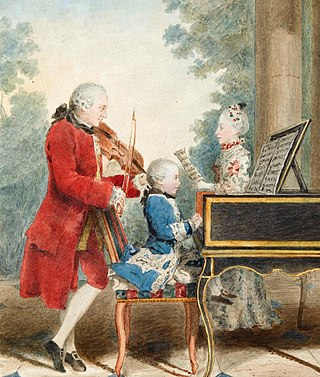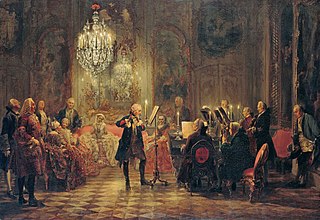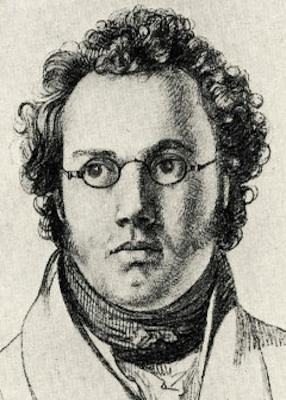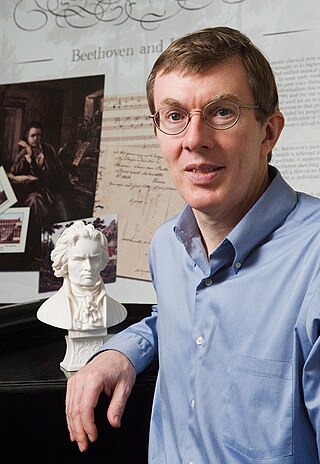Related Research Articles

The Classical Period was an era of classical music between roughly 1750 and 1820.

In classical music, a fugue is a contrapuntal, polyphonic compositional technique in two or more voices, built on a subject that is introduced at the beginning in imitation, which recurs frequently throughout the course of the composition. It is not to be confused with a fuguing tune, which is a style of song popularized by and mostly limited to early American music and West Gallery music. A fugue usually has three main sections: an exposition, a development, and a final entry that contains the return of the subject in the fugue's tonic key. Fugues can also have episodes, which are parts of the fugue where new material often based on the subject is heard; a stretto, when the fugue's subject overlaps itself in different voices, or a recapitulation. A popular compositional technique in the Baroque era, the fugue was fundamental in showing mastery of harmony and tonality as it presented counterpoint.

Chamber music is a form of classical music that is composed for a small group of instruments—traditionally a group that could fit in a palace chamber or a large room. Most broadly, it includes any art music that is performed by a small number of performers, with one performer to a part. However, by convention, it usually does not include solo instrument performances.
Sonata form is a musical structure generally consisting of three main sections: an exposition, a development, and a recapitulation. It has been used widely since the middle of the 18th century.

The Trout Quintet (Forellenquintett) is the popular name for the Piano Quintet in A major, D. 667, by Franz Schubert. The piano quintet was composed in 1819, when he was 22 years old; it was not published, however, until 1829, a year after his death.
Susan Kaye McClary is an American musicologist associated with "new musicology". Noted for her work combining musicology with feminist music criticism, McClary is professor of musicology at Case Western Reserve University.
Sonata da chiesa is a 17th-century genre of musical composition for one or more melody instruments and is regarded an antecedent of later forms of 18th century instrumental music. It generally comprises four movements, typically a largo prelude followed by a fugal allegro, an expressive slow movement, and an allegro finale, although there are also many variations of this pattern.

Allen Forte was an American music theorist and musicologist. He was Battell Professor Emeritus of the Theory of Music at Yale University and specialized in 20th-century atonal music and music analysis.
Sonata form is one of the most influential ideas in the history of Western classical music. Since the establishment of the practice by composers like C.P.E. Bach, Haydn, Mozart, Beethoven, and Schubert and the codification of this practice into teaching and theory, the practice of writing works in sonata form has changed considerably.

Ludwig van Beethoven is one of the most influential figures in the history of classical music. Since his lifetime, when he was "universally accepted as the greatest living composer", Beethoven's music has remained among the most performed, discussed and reviewed in the Western world. Scholarly journals are devoted to analysis of his life and work. He has been the subject of numerous biographies and monographs, and his music was the driving force behind the development of Schenkerian analysis. He is widely considered among the most important composers, and along with Bach and Mozart, his music is the most frequently recorded.
Elaine Rochelle Sisman is an American musicologist. The Anne Parsons Bender Professor of Music at Columbia University, Sisman specializes in music, rhetoric, and aesthetics of the 18th and 19th centuries, and has written on such topics as memory and invention in late Beethoven, ideas of pathétique and fantasia around 1800, Haydn's theater symphonies, the sublime in Mozart's music, and Brahms's slow movements. She is the author of Haydn and the Classical Variation and Mozart: The 'Jupiter' Symphony and editor of Haydn and His World. Her monograph-length article on "variations" appears in the revised New Grove Dictionary of Music and Musicians, and she is at work on studies of music and melancholy, of Don Giovanni, and of the opus-concept in the eighteenth century.

The String Quartet No. 19 in C Major, K. 465 by Wolfgang Amadeus Mozart, nicknamed "Dissonance" on account of the unusual counterpoint in its slow introduction. It is perhaps the most famous of his quartets.
John Joseph Daverio was a violinist, scholar, teacher and author, best known for his writings on the music of Robert Schumann and Johannes Brahms. His research interests centered around Austro-German composers including J. S. Bach, Mozart, Schubert, Wagner and Post-Romantic composers such as R. Strauss and Mahler. Just before his sudden death, he was exploring the concept of "late Style" in the music of Haydn, Mozart, and Beethoven. All of his writings feature the relation of music to literature and philosophy.
Edward Toner Cone was an American composer, music theorist, pianist, and philanthropist.
Wolfgang Amadeus Mozart's String Quartet No. 18 in A major, K. 464, the fifth of the Quartets dedicated to Haydn, was completed in 1785. Mozart's autograph catalogue states as the date of composition "1785. / the 10th January". It is in four movements:
- Allegro
- Menuetto and Trio
- Andante, D major
- Allegro non troppo
Lewis H. Lockwood is an American musicologist whose main fields are the music of the Italian Renaissance and the life and work of Ludwig van Beethoven. Joseph Kerman described him as "a leading musical scholar of the postwar generation, and the leading American authority on Beethoven".
William E. Caplin is an American music theorist who lives and works in Montreal, Quebec, Canada, where he is a James McGill Professor at the Schulich School of Music of McGill University. Caplin served as president of the Society for Music Theory from 2005 to 2007 and was its vice-president from 2001 to 2003. His earlier work concentrated on the history of music theory, but he is best known for a series of articles and two books on musical form in European music around 1800. The first of those books, Classical Form: A Theory of Formal Functions for the Music of Haydn, Mozart, and Beethoven has been widely influential and was a major factor in the revival of interest in musical form in North-American music theory.

William Andrew Kinderman is an American author and music scholar who plays the piano.

The transition from the classical period of European Art music, which lasted around 1750 to 1820, to Romantic music, which lasted around 1800 to 1910.
Vasili Byros is a Greek-American music theorist, musicologist and pianist. He is best known for his contributions to the field of music schemata theory and partimento.
References
- ↑ William Caplin, "On the Relation of Musical 'Topoi' to Formal Function" Eighteenth-Century Music 11(1) March, 2005.
- ↑ Raymond Monelle, The Sense of Music:Semiotic Essays Princeton Univ. Press, 2000
- 1 2 Kofi Agawu, "Leonard G. Ratner, 1916-2011" Ad Parnassum: A Journal of Eighteenth- and Nineteenth-Century Instrumental Music 10 (19), April 2012, 190-194